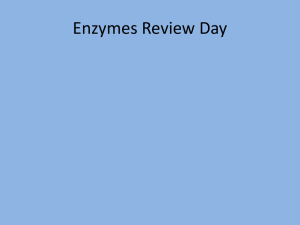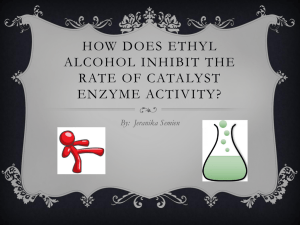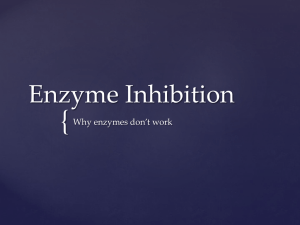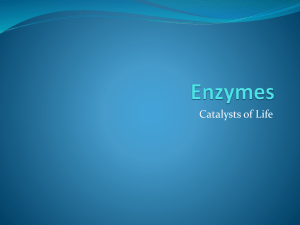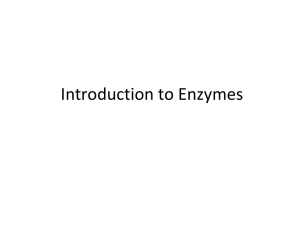(1) Enzyme properties
advertisement
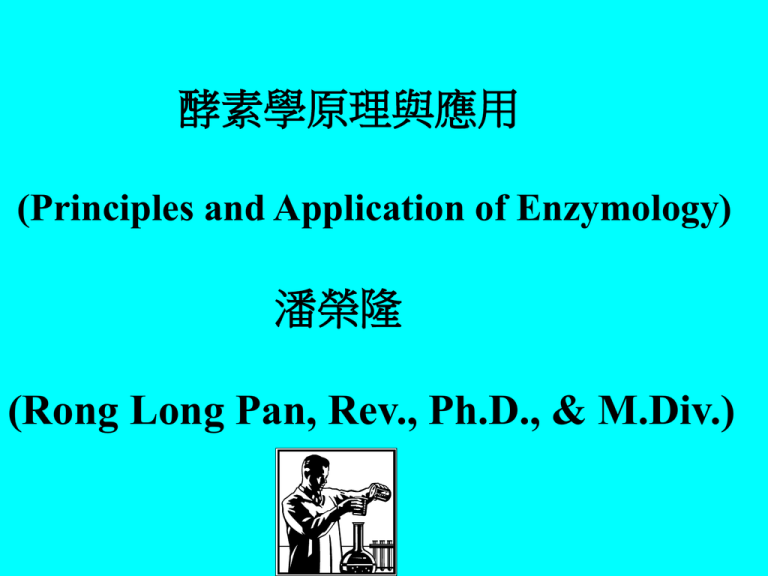
酵素學原理與應用 (Principles and Application of Enzymology) 潘榮隆 (Rong Long Pan, Rev., Ph.D., & M.Div.) Outlines I. Introduction to enzymology II. The structure of enzymes III. Specificity of enzyme action IV. Bioenergetics of enzyme action V. Investigation of enzyme active site structure VI. Chemical nature of enzyme catalysis VII. Kinetics of enzymatic reaction VIII. Enzyme inhibition IX. Control of enzyme action X. Enzyme isolation and purification XI. Application of enzymology in medicine XII. Biotechnological applications of enzymes 酵素: 脆弱、敏感、而又美麗的生命組成分子 Definition Enzymes are biological catalysts. Enzyme components: Active enzyme or Inactive protein (Apoenzyme) + Cofactor [called: Holoenzyme] Cofactor: Coenzyme (Organic molecule) Or Metal (1) Enzyme properties (a) Physical properties (b) Chemical properties (2) Structure (3) Kinetics (4) Thermodynamics (5) Biological properties 3. Basic techniques: A. General technique: 1. Potentiometry, 2. Spectrophotometry, 3. Centrifugation 4. Ion exchange, 5. Gel permeation chromatography, 6. Electrophoresis 7. Affinity chromatography, 8. Radiochemistry, 9. Immunochemical techniques, 10. Protein purification, 11. Other non-conventional biochemical techniques B. Enzyme Kinetics: C. Spectroscopy for enzymology: 1. UV/Vis spectrophotometry, 2. IR, Raman spectrophotometry, 3. CD and ORD, 4. Fluorescence and phosphorescence, 5. ESR and NMR, 6. Electron microscopy, 7. X-ray and neutron diffraction Enzyme classification A. Organizations handle the enzyme classification: International Union of Biochemistry International Union of Pure and Applied Chemistry. B. Name of enzymes: (a) Name of substrate + (b) -ase at end of words. The Enzyme Commission (1961) offered code numbers (EC) with four elements (1)First figure: Six main classes: 1) Oxidoreductase 氧化還原酵素 2) Transferase 轉移酵素 3) Hydrolase 水解酵素 4) Lyase 裂解酵素 5) Isomerase 異構轉化酵素 6) Ligase 連接酵素 New set of notation and terminology Reactant -----> Substrate [S] Catalyst -----> Enzyme [E] Product -----> Product [P] Enzyme-substrate complex Maximum velocity Machaelis constant [ES] Vmax Km Biocatalysts Enzymes: proteins with catalytic activity Ribozyme: fragment of RNA can also act as catalyst for reaction involving hydrolysis of RNA. Abzyme: antibody which binds the complex of transition state of an reaction can catalyze this reaction. III. Specificity of enzyme action (1). High reaction rate: 106~1012 higher, even 1014 higher. rate ratio with/without enzyme eg. hexokinase > 1010 phosphorylase > 3 x 1011 alcohol DHase > 2 x 108 urase kinase > 104. (2). Mild reaction conditions: mostly, temperature < 100 oC atmospheric pressure, neutral pH. eg. N2 --------> NH3 [1]. Nitrogenase, at 300 K, neutral pH, requires ATP. [2]. Industrial (Harber) method: N2 + H2 --------> NH3 at 700~900 K, 1100~900 atmospheric pressure, catalyst: Fe, oxides of other metals. (3). High specificity, less side effects [1]. Protein synthesis by ribosome: 1,000 a.a. polypeptide, no error. Chemical protein synthesis: ~50 a.a. oligopeptide, many errors. [2]. Group specificity [3]. Absolute or near absolute specificity (a). Stereochemistry (b). Proof-reading system: DNA or protein synthesis, 1 mutation/108~1010. IV. Bioenergetics of enzyme action V. Active site structure of enzyme Active site studies Identification of active site Trapping the enzyme-substrate complex The use of substrate analogue Modification of active site residues Modification by protease Modification by site-directed mutagenesis Effect of pH, etc Substrate analogue Chemical modification Mechanism of enzyme action VI. Chemical nature of enzyme catalysis Mechanism for enzyme specificity V. Kinetics of enzymatic reaction Enzyme A ---------------- B Michaelis-Menten reaction k1 k2 E + S ------ ES ----- E + P k-1 Vmax [S] v = ---------------Km + [S] Lineweaver-Burke 1 Km 1 1 ---- = ------ x ------ + -----v [S] Vmax Vmax Eadie-Hofstee v Vmax v ---- = ------- - -----[S] Km Km VI. Kinetics of enzyme inhibition Competitive inhibition Non-competitive inhibition IX. Control of enzyme action If no control, all metabolic process would become equilibrium with surroundings. Two ways of control: (1). amount of enzyme, synthesis and degradation; long term response to environment; (2). activity of enzyme already presented in the cell. Control of activity of single enzymes (1). change in covalent structure of an enzyme; (2). conformational changes caused by regulators (3). specific inhibitor macromolecules (4). availability of substrate or cofactor (5). product inhibition (6). non enzyme-catalyzed reactions (Cont.) Covalent modifications of enzymes: Reversible vs Irreversible (1). Phosphorylation (2). ADP-ribosylation (3). Adenylylation (4). Methylation (5). Acetylation (6). Tyrosinolation (7). Sulphation Feedback control of metabolism Cooperative control of enzyme X. Enzyme isolation and purification Strategy to Enzyme Purification Highly Purified protein is very important to biochemical and biophysical studies of proteins. To gain maximum maximum possible purity. catalytic activity, 2. Basic steps of purification: a). Development of suitable assay procedures b). Selection of material sources c). Solubilization of desired molecules d). Stabilization of molecules repeatedly at each steps e). Development of a series of isolation and concentration procedures Choice of methods depends on: 1). Scale of the preparation and the yield of enzyme required. 2). Time availabile for the preparation. 3). The equipment and expertise available in lab. Development of enzyme assay Four criteria: 1). Absolute specificity 2). High sensitivity 3). High precision 4). Convenience and low cost Methods for purification of enzymes 1. Centrifugation 2. Ion exchange, 3. Gel permeation chromatography, 4. Electrophoresis 5. Affinity chromatography, 6. Immunochemical techniques, XI. Application of enzymology in medicine XII. Biotechnological applications of enzymes Figure The protein engineering cycle. The process starts with the isolation and characterisation of the required enzyme. XII.-(a) XII.-(b) 酵素固定化(Immobolized enzymes) XII.-(c)生物感應器 (Biosensor) 生物感測器生物分子辨認元件之組成份子 XII.-(d)生物電池 (Bioelectrochemical cell)



